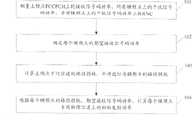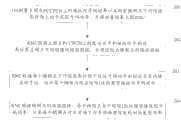CN101119145B - Open-loop Power Control Method of Auxiliary Frequency Point in Time Division-Synchronous Code Division Multiple Access System - Google Patents
Open-loop Power Control Method of Auxiliary Frequency Point in Time Division-Synchronous Code Division Multiple Access SystemDownload PDFInfo
- Publication number
- CN101119145B CN101119145BCN2006101092650ACN200610109265ACN101119145BCN 101119145 BCN101119145 BCN 101119145BCN 2006101092650 ACN2006101092650 ACN 2006101092650ACN 200610109265 ACN200610109265 ACN 200610109265ACN 101119145 BCN101119145 BCN 101119145B
- Authority
- CN
- China
- Prior art keywords
- frequency point
- signal code
- code power
- power
- received signal
- Prior art date
- Legal status (The legal status is an assumption and is not a legal conclusion. Google has not performed a legal analysis and makes no representation as to the accuracy of the status listed.)
- Expired - Fee Related
Links
Images
Landscapes
- Mobile Radio Communication Systems (AREA)
Abstract
Description
Claims (10)
Translated fromChinesePriority Applications (1)
| Application Number | Priority Date | Filing Date | Title |
|---|---|---|---|
| CN2006101092650ACN101119145B (en) | 2006-08-03 | 2006-08-03 | Open-loop Power Control Method of Auxiliary Frequency Point in Time Division-Synchronous Code Division Multiple Access System |
Applications Claiming Priority (1)
| Application Number | Priority Date | Filing Date | Title |
|---|---|---|---|
| CN2006101092650ACN101119145B (en) | 2006-08-03 | 2006-08-03 | Open-loop Power Control Method of Auxiliary Frequency Point in Time Division-Synchronous Code Division Multiple Access System |
Publications (2)
| Publication Number | Publication Date |
|---|---|
| CN101119145A CN101119145A (en) | 2008-02-06 |
| CN101119145Btrue CN101119145B (en) | 2010-10-27 |
Family
ID=39055106
Family Applications (1)
| Application Number | Title | Priority Date | Filing Date |
|---|---|---|---|
| CN2006101092650AExpired - Fee RelatedCN101119145B (en) | 2006-08-03 | 2006-08-03 | Open-loop Power Control Method of Auxiliary Frequency Point in Time Division-Synchronous Code Division Multiple Access System |
Country Status (1)
| Country | Link |
|---|---|
| CN (1) | CN101119145B (en) |
Families Citing this family (3)
| Publication number | Priority date | Publication date | Assignee | Title |
|---|---|---|---|---|
| CN101835253B (en)* | 2009-03-12 | 2013-08-07 | 中兴通讯股份有限公司 | UE (User Equipment) side uplink power control device and method in TD-SCDMA (Time Division-Synchronous Code Division Multiple Access) system |
| CN102209375A (en)* | 2010-03-31 | 2011-10-05 | 爱立信电话股份有限公司 | Method for setting downlink channel power and equipment implementing same |
| CN102665242B (en)* | 2012-05-28 | 2014-07-09 | 鼎桥通信技术有限公司 | Method and equipment for selecting AMR (adaptive multi-rate) speech coding rate during initial access |
Citations (4)
| Publication number | Priority date | Publication date | Assignee | Title |
|---|---|---|---|---|
| CN1545217A (en)* | 1999-03-22 | 2004-11-10 | �����ּ�����˾ | Weighted open loop power control in time division multiplexed communication systems |
| WO2005064821A1 (en)* | 2003-12-29 | 2005-07-14 | Samsung Electronics Co., Ltd. | Method and apparatus for adaptive open-loop power control in mobile communication system using tdd |
| CN1719935A (en)* | 2004-07-09 | 2006-01-11 | 中兴通讯股份有限公司 | Auxiliary carrier signal quality estimating and carrier selecting method for TD-SCDMA system |
| CN1750700A (en)* | 2004-09-14 | 2006-03-22 | 中兴通讯股份有限公司 | Mobile terminal measuring control method in multiple carrier frequency small region and multiple small region |
- 2006
- 2006-08-03CNCN2006101092650Apatent/CN101119145B/ennot_activeExpired - Fee Related
Patent Citations (4)
| Publication number | Priority date | Publication date | Assignee | Title |
|---|---|---|---|---|
| CN1545217A (en)* | 1999-03-22 | 2004-11-10 | �����ּ�����˾ | Weighted open loop power control in time division multiplexed communication systems |
| WO2005064821A1 (en)* | 2003-12-29 | 2005-07-14 | Samsung Electronics Co., Ltd. | Method and apparatus for adaptive open-loop power control in mobile communication system using tdd |
| CN1719935A (en)* | 2004-07-09 | 2006-01-11 | 中兴通讯股份有限公司 | Auxiliary carrier signal quality estimating and carrier selecting method for TD-SCDMA system |
| CN1750700A (en)* | 2004-09-14 | 2006-03-22 | 中兴通讯股份有限公司 | Mobile terminal measuring control method in multiple carrier frequency small region and multiple small region |
Also Published As
| Publication number | Publication date |
|---|---|
| CN101119145A (en) | 2008-02-06 |
Similar Documents
| Publication | Publication Date | Title |
|---|---|---|
| CN100593286C (en) | Method and apparatus for high rate packet data and low latency data transmission | |
| CN105165100B (en) | Systems and methods for fractional carrier sense multipoint access/collision avoidance for WLANs | |
| CN103210688B (en) | Uplink transmission power control method and device for distributed antenna mobile communication system | |
| CN201369740Y (en) | Wireless transmitting/receiving unit configured to report channel quality index | |
| CN201699996U (en) | Wireless transmitting and receiving unit | |
| US20120176955A1 (en) | Radio system and radio communication method | |
| CN103430601A (en) | Method for communication based on identifying information assignment and apparatus for the same | |
| CN101518144A (en) | Method and apparatus for assigning cell and resource blocks through interference optimization | |
| CN104869649B (en) | Coordinated multipoint transmission multiple cell measures pilot frequency collocation method in a kind of LTE system | |
| CN103052111A (en) | Method for selecting interuser communication modes under different base stations | |
| CN103096334B (en) | Determine the method and device on cell extension biasing border | |
| CN101729106A (en) | Enhanced up-link power control based on interference management and transmission quality control | |
| AU2021378685B2 (en) | Method for determining spatial reuse parameter field in ppdu and related apparatus | |
| WO2017173920A1 (en) | Power control method and device | |
| CN104185261A (en) | Method, apparatus and system for wireless communication in wireless communication system | |
| CN102088423A (en) | Method and device for measuring reference signal receiving power of time division duplex system | |
| CN101635933B (en) | Method, system and equipment for detecting path loss | |
| WO2013163905A1 (en) | Uplink/downlink configuration method and device in system using time division duplex communication mode | |
| CN103379647B (en) | A kind of cell carrier method of adjustment of heterogeneous network and heterogeneous network | |
| CN103281733A (en) | Downlink transmission method and control equipment, base station and heterogeneous system in heterogeneous network | |
| CN101119145B (en) | Open-loop Power Control Method of Auxiliary Frequency Point in Time Division-Synchronous Code Division Multiple Access System | |
| CN102137480A (en) | Method and system for adjusting downlink power of Femtocell base station | |
| CN102118234A (en) | Channel quality indicator (CQI) feedback method, communication equipment and communication system | |
| CN111294818B (en) | A channel quality estimation method, terminal equipment and network equipment | |
| CN103716890A (en) | Uplink interference compensation method and device |
Legal Events
| Date | Code | Title | Description |
|---|---|---|---|
| C06 | Publication | ||
| PB01 | Publication | ||
| C10 | Entry into substantive examination | ||
| SE01 | Entry into force of request for substantive examination | ||
| C14 | Grant of patent or utility model | ||
| GR01 | Patent grant | ||
| ASS | Succession or assignment of patent right | Owner name:CHINA POTEVIO CO., LTD. Free format text:FORMER OWNER: PUTIAN IT TECH INST CO., LTD. Effective date:20130428 | |
| C41 | Transfer of patent application or patent right or utility model | ||
| C56 | Change in the name or address of the patentee | Owner name:PUTIAN IT TECH INST CO., LTD. Free format text:FORMER NAME: PUTIAN INST. OF INFORMATION TECHNOLOGY | |
| CP03 | Change of name, title or address | Address after:100080 Beijing, Haidian, North Street, No. two, No. 6, No. Patentee after:PETEVIO INSTITUTE OF TECHNOLOGY Co.,Ltd. Address before:100085, No. two, 2 street, base of information industry, Beijing Patentee before:POTEVIO Institute of Information Technology | |
| TR01 | Transfer of patent right | Effective date of registration:20130428 Address after:100080, No. two, 2 street, Zhongguancun science and Technology Park, Beijing, Haidian District Patentee after:CHINA POTEVIO CO.,LTD. Address before:100080 Beijing, Haidian, North Street, No. two, No. 6, No. Patentee before:PETEVIO INSTITUTE OF TECHNOLOGY Co.,Ltd. | |
| ASS | Succession or assignment of patent right | Owner name:PUTIAN IT TECH INST CO., LTD. Free format text:FORMER OWNER: CHINA POTEVIO CO., LTD. Effective date:20130509 | |
| C41 | Transfer of patent application or patent right or utility model | ||
| TR01 | Transfer of patent right | Effective date of registration:20130509 Address after:100080 Beijing, Haidian, North Street, No. two, No. 6, No. Patentee after:PETEVIO INSTITUTE OF TECHNOLOGY Co.,Ltd. Address before:100080, No. two, 2 street, Zhongguancun science and Technology Park, Beijing, Haidian District Patentee before:CHINA POTEVIO CO.,LTD. | |
| PE01 | Entry into force of the registration of the contract for pledge of patent right | Denomination of invention:Auxiliary frequency point opened loop power control method in time division synchronous CDMA system Effective date of registration:20131210 Granted publication date:20101027 Pledgee:Bank of Beijing Limited by Share Ltd. Century City Branch Pledgor:PETEVIO INSTITUTE OF TECHNOLOGY Co.,Ltd. Registration number:2013990000954 | |
| PLDC | Enforcement, change and cancellation of contracts on pledge of patent right or utility model | ||
| C56 | Change in the name or address of the patentee | Owner name:POTEVIO INFORMATION TECHNOLOGY CO., LTD. Free format text:FORMER NAME: PUTIAN IT TECH INST CO., LTD. | |
| CP01 | Change in the name or title of a patent holder | Address after:100080 Beijing, Haidian, North Street, No. two, No. 6, No. Patentee after:POTEVIO INFORMATION TECHNOLOGY Co.,Ltd. Address before:100080 Beijing, Haidian, North Street, No. two, No. 6, No. Patentee before:PETEVIO INSTITUTE OF TECHNOLOGY Co.,Ltd. | |
| PC01 | Cancellation of the registration of the contract for pledge of patent right | Date of cancellation:20151102 Granted publication date:20101027 Pledgee:Bank of Beijing Limited by Share Ltd. Century City Branch Pledgor:POTEVIO INFORMATION TECHNOLOGY Co.,Ltd. Registration number:2013990000954 | |
| PLDC | Enforcement, change and cancellation of contracts on pledge of patent right or utility model | ||
| PM01 | Change of the registration of the contract for pledge of patent right | Change date:20151102 Registration number:2013990000954 Pledgor after:POTEVIO INFORMATION TECHNOLOGY Co.,Ltd. Pledgor before:PETEVIO INSTITUTE OF TECHNOLOGY Co.,Ltd. | |
| PE01 | Entry into force of the registration of the contract for pledge of patent right | Denomination of invention:Auxiliary frequency point opened loop power control method in time division synchronous CDMA system Effective date of registration:20151105 Granted publication date:20101027 Pledgee:Bank of Beijing Limited by Share Ltd. Century City Branch Pledgor:POTEVIO INFORMATION TECHNOLOGY Co.,Ltd. Registration number:2015990000948 | |
| PLDC | Enforcement, change and cancellation of contracts on pledge of patent right or utility model | ||
| PC01 | Cancellation of the registration of the contract for pledge of patent right | Date of cancellation:20161008 Granted publication date:20101027 Pledgee:Bank of Beijing Limited by Share Ltd. Century City Branch Pledgor:POTEVIO INFORMATION TECHNOLOGY Co.,Ltd. Registration number:2015990000948 | |
| PLDC | Enforcement, change and cancellation of contracts on pledge of patent right or utility model | ||
| PE01 | Entry into force of the registration of the contract for pledge of patent right | Denomination of invention:Auxiliary frequency point opened loop power control method in time division synchronous CDMA system Effective date of registration:20161011 Granted publication date:20101027 Pledgee:Bank of Beijing Limited by Share Ltd. Century City Branch Pledgor:POTEVIO INFORMATION TECHNOLOGY Co.,Ltd. Registration number:2016990000859 | |
| PLDC | Enforcement, change and cancellation of contracts on pledge of patent right or utility model | ||
| PC01 | Cancellation of the registration of the contract for pledge of patent right | ||
| PC01 | Cancellation of the registration of the contract for pledge of patent right | Date of cancellation:20170802 Granted publication date:20101027 Pledgee:Bank of Beijing Limited by Share Ltd. Century City Branch Pledgor:POTEVIO INFORMATION TECHNOLOGY Co.,Ltd. Registration number:2016990000859 | |
| CF01 | Termination of patent right due to non-payment of annual fee | Granted publication date:20101027 | |
| CF01 | Termination of patent right due to non-payment of annual fee |


